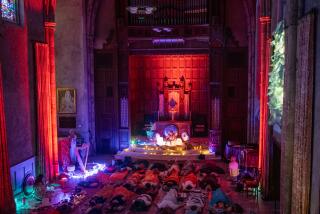Patience Is Part of Bathing in Africa
When traveling for any length of time in the African interior, pay attention to the three killer B’s: baths, bowels and bedbugs.
I’ve been bitten by bedbugs in America as often as in Africa, but I wouldn’t think of going into African boats, trains or village hotels without a can of bug spray, however rarely I might need it. Bedbugs can spoil a trip.
The rules are simple for the other two B’s: Never, ever pass up the chance to use a toilet or a sink. And as for soap and toilet paper, never leave home without them.
If you want to know how I’ve dealt with the bowels problem in my thousands of miles of travel in East and Central Africa, you’ll have to wait for my posthumous memoirs. But here are some of the baths I have known:
On the River Congo (the River Zaire within that country), a tin can is as necessary as a cooking pot. The ideal can is about a half-gallon in size and has a handle to which you can attach a length of rope. You drop the can into the river, fill it up and haul it in. You can fill a bucket (mandatory for washing clothes) or use the can as an intermittent, hand-operated shower head.
The men wear shorts as they bathe at the edge of the barges (the big riverboat pushes seven barges the 1,000 miles upriver from Kinshasa to Kisangani), washing the shorts along with their bodies. A woman usually covers herself with a cloth about 36 inches by 72, called khanga in Swahili, and scrubs herself beneath it.
You can poke holes in the bottom of a bucket, fill it with water and stand under it. I don’t advise it. First you need two buckets, and the timing of the fill-up and jump-under requires the athleticism of an Ozzie Smith. Besides, the water will run out just when your hair is fully soaped.
On the other hand, if you have lots of quick servants (as Karen Blixen, Elspeth Huxley and the like did), it works.
On the Congo barges, and in many of the smallest hotels, the toilet and bathroom are one, presenting solutions to two of the B’s problems together. The area is generally the size of a small closet and has a hole in the floor. On one boat on Lake Tanganyika, a pipe provided a stream of water, but generally this is bucket time.
Before embarking on a 5,000-mile, cross-continent journey by public transportation in 1985, I was worried: I had never learned the art of bathing out of a bucket despite years of opportunity. I usually scored well on my legs and arms, but I could wash my hair only by emptying the bucket over my head in a grand finale. This works fine outdoors or in a combination toilet-bathroom. However, it won’t do in a hotel room or in your host’s bedroom.
Traveling up the Congo, I left the bucket brigade when I moved from second-class on the barges to first-class on the big boat. Each pair of rooms shared a bath. It was unlighted, though there were fixtures, but had a standard toilet and bathtub.
However, I never immersed myself in the water. The cold water came straight from the river, the hot water straight from the boiler. I didn’t want to be caught sitting if the cold water was suddenly cut. So I sat on the edge of the tub, my feet on the far side out of the water, and continued my studies in bathing with cupped hands.
I’ve seen people bathe in streams and lakes from the middle of Port-au-Prince, Haiti, to the Peloponnesus in Greece, in Peninsular Malaysia and everywhere across the center of Africa.
I once had a lovely bath in a small, swift-moving stream in Mang’ola, Tanzania, near Lake Eyasi. Otherwise, I’ve shunned freshwater in Africa because of the schistosomes, teeny-weeny parasitic worms that have two hosts: snails and humans. The debilitating disease they cause, schistosomiasis (or bilharzia), is a scourge in tropical Africa and some other parts of the world.
I bathed on the boats with Congo water, figuring the schistosomes wouldn’t have time to burrow through my skin and head for my liver, but I wouldn’t bathe in the river itself. Once I had to go five days without a bath on a train trip because I wouldn’t get into the river, although most other passengers did.
But in eastern Zaire, I settled into the biggest bathtub I’ve enjoyed: Lake Tanganyika (Zairians call it Tanganika). My fellow wasafiri (travelers; the word comes from safari, a journey) were bathing off the rocks near where our boat was berthed while taking on cargo. I discovered that by scrambling over the rocks a couple of hundred feet, there was a lovely, deserted beach under the hills that surround the lake.
In mid-bath, as my clothes were drying on the rocks, several boys approached in a dugout canoe, drawn by the unimaginable sight of a naked mzungu (white person) in their lake. When they got close enough, I hollered in Swahili that I was going to tell their parents, and they rushed away.
I had completed two months of undergraduate bathing studies when I arrived in Lubumbashi in September, 1985, where I was staying with Mama Eliza, with whose family I had traveled by train, boat and train again from Kisangani.
She’d give me a bucket of water and leave me in her room while she cooked and conversed with neighbors outside. I’d emerge after 20 minutes, looking good and feeling better, and present her with half a bucket of unused water.
By then, I had learned that there are only two ways to handle the bucket bath, both starting with the absolute necessity to keep the soap out of the water. This is no problem if you don’t have to worry about where the water lands when it streams off your back. You simply rinse away from the bucket and make your handfuls of water count.
The other way, the one I used at Mama Eliza’s, is cheating: I used a second bucket.
So sue me.
More to Read
Sign up for The Wild
We’ll help you find the best places to hike, bike and run, as well as the perfect silent spots for meditation and yoga.
You may occasionally receive promotional content from the Los Angeles Times.






